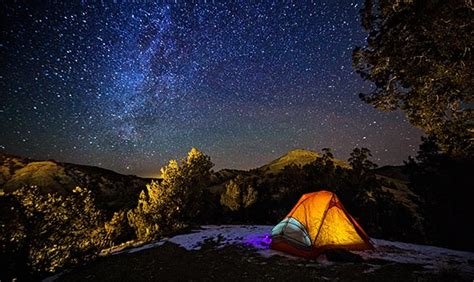Best Campgrounds for Stargazing and Night Sky Photography
Are you passionate about stargazing and night sky photography? There’s nothing quite like being surrounded by the beauty of the night sky in a peaceful campground, far away from the city lights. In this blog post, we will explore the best campgrounds for stargazing and night sky photography, as well as provide tips and advice for making the most of your nighttime adventures.
From choosing the right location and equipment for stargazing to preparing for night sky photography and identifying constellations, we’ll cover everything you need to know for a successful stargazing trip. Additionally, we’ll discuss essential camping gear and safety precautions to ensure a comfortable and secure experience under the stars. Whether you’re a seasoned stargazer or a beginner looking to capture the beauty of the Milky Way, this blog post will provide you with the information you need for an unforgettable nighttime adventure. So, grab your gear and get ready to explore the wonders of the night sky!
Choosing the Right Location
When stargazing, choosing the right location is crucial for a successful experience. The first step is to find a place with minimal light pollution, where the night sky is at its clearest. This could be a remote area far from urban centers, or a designated dark sky park with strict lighting regulations. The next consideration is the weather – clear skies are essential for stargazing, so checking the forecast for cloud cover and precipitation is important. Additionally, selecting a location with a wide, unobstructed view of the horizon will enhance the stargazing experience and allow for better observation of celestial events.
Another factor to consider when choosing the right location for stargazing is the accessibility and safety of the area. It’s important to select a place that is easily reachable, especially if bringing along equipment for telescopic observation or night sky photography. Furthermore, being aware of potential hazards such as wildlife, rough terrain, or extreme weather conditions is crucial for a safe and enjoyable stargazing experience. Lastly, taking into account the time of year and the position of the stars and constellations in the night sky when selecting a location will help to optimize the potential for witnessing celestial wonders.
Ultimately, the right location for stargazing can greatly impact the overall experience, so taking the time to research and choose an ideal spot will pay off in the form of unforgettable celestial views and moments of awe and wonder.
In conclusion, choosing the right location is a crucial aspect of stargazing and can greatly influence the quality of the experience. By considering factors such as light pollution, weather, accessibility, and celestial positioning, enthusiasts can ensure an optimal environment for observing the wonders of the night sky.
Equipment and Gear for Stargazing
When it comes to stargazing, having the right equipment and gear can make all the difference. Whether you’re a beginner or a seasoned enthusiast, there are a few essential items that can enhance your stargazing experience. One of the most important pieces of equipment is a reliable telescope or binoculars. These will allow you to get a closer look at celestial objects such as planets, stars, and galaxies. It’s also important to have a sturdy tripod to mount your telescope or binoculars on, as this will help stabilize your view and prevent shaking.
Another crucial piece of gear for stargazing is a star chart or planisphere. These tools can help you navigate the night sky and locate specific constellations, stars, and other celestial objects. Additionally, investing in a red flashlight can be helpful, as it allows you to see in the dark without disrupting your night vision.
Comfort is also key when stargazing, so be sure to bring along a comfortable camping chair or blanket to sit or lie on while observing the night sky. You may also want to pack some warm clothing, as temperatures can drop significantly at night, especially in open areas away from city lights.
Lastly, don’t forget to bring along a notebook and pen to jot down any observations or celestial events that you witness. Keeping a stargazing journal can be a fun and rewarding way to document your experiences and track your progress as an amateur astronomer.
Preparing for the Night Sky Photography
When preparing for a night sky photography session, it is important to take into account several factors in order to capture stunning images of the stars and the Milky Way. One of the most crucial elements to consider is the location where you will be shooting. Look for a spot with minimal light pollution and clear skies for the best results.
Next, make sure you have the right equipment and gear for night sky photography. A sturdy tripod is a must-have to keep your camera stable during long exposures. Additionally, a wide-angle lens with a low aperture and high ISO capabilities is ideal for capturing the night sky in all its glory.
Before heading out for your night sky photography adventure, make sure you have all the necessary camping essentials to keep you comfortable and safe throughout the night. This includes warm clothing, a headlamp, food and water, and a reliable navigation device in case you venture far from your base.
Finally, it’s important to take safety precautions when embarking on a nighttime photography expedition. Let someone know your plans and expected return time, and always be aware of your surroundings, especially in remote areas. By considering these factors and being well-prepared, you can make the most of your night sky photography experience and capture breathtaking images of the cosmos.
Camping Essentials for Stargazing Trips
When preparing for a stargazing trip, it’s important to ensure that you have all the necessary camping essentials to make the experience as enjoyable as possible. One of the most important pieces of equipment is a quality tent that will provide shelter and protection from the elements, as well as a comfortable place to rest at night.
Another crucial item to bring along is a sleeping bag that is suitable for the weather conditions of the location you will be visiting. It’s also a good idea to pack a sleeping pad for added comfort and insulation from the ground.
Additionally, having a reliable camp stove and cooking equipment is essential for preparing meals during your stargazing adventure. Packing non-perishable food items and plenty of water is also important for ensuring that you have sustenance throughout your trip.
Finally, be sure to pack a first-aid kit and emergency supplies in case of any unexpected injuries or situations. Having these camping essentials will help ensure that you have a safe and enjoyable stargazing trip.
Tips for Capturing the Milky Way
When it comes to capturing the Milky Way in all its glory, the first step is to find a location with minimal light pollution. This means heading to remote areas away from city lights. The darker the sky, the clearer the Milky Way will appear in your photographs.
Next, make sure you have the right equipment and gear. A sturdy tripod is essential for keeping your camera steady during long exposures. A wide-angle lens with a low aperture will allow more light to enter the camera, resulting in brighter and more detailed shots of the Milky Way.
Preparing for the night sky photography involves being patient and allowing your eyes to adjust to the darkness. Once your eyes have adjusted, use a headlamp with a red light to navigate and adjust your camera settings without disrupting your night vision.
Finally, capturing the Milky Way also requires understanding the best times to photograph it. New moon nights are ideal as they provide the darkest skies and allow the Milky Way to shine brightly. It’s also important to check the weather forecast and plan your shoot on clear, cloudless nights for the best results in capturing the beauty of the Milky Way.
Identifying Constellations and Star Trails
When it comes to identifying constellations and star trails, the first step is to find a suitable location with minimal light pollution. This will ensure that you have a clear view of the night sky and can easily pick out the different constellations. Once you have found your location, it’s important to have the right equipment and gear. A good pair of binoculars or a telescope can be incredibly helpful in spotting constellations and star trails.
Additionally, it’s important to familiarize yourself with the night sky and the different constellations. There are several mobile apps and websites that can help you identify constellations and track star trails. Some of these apps even allow you to input your location and time to get real-time information about the night sky.
When it comes to capturing star trails, a sturdy tripod is essential to keep your camera steady during long exposures. It’s also important to have a basic understanding of photography settings such as ISO, shutter speed, and aperture to capture the beauty of the night sky. Look for a dark, clear night with minimal light pollution for the best results.
Lastly, safety precautions are important when embarking on nighttime adventures. Always let someone know your plans and expected return time, and make sure to dress warmly and bring plenty of provisions. With the right location, equipment, and knowledge, identifying constellations and capturing star trails can be a truly magical experience.
Safety Precautions for Nighttime Adventures
When embarking on nighttime adventures such as stargazing, it is important to prioritize safety precautions to ensure a smooth and secure experience. One essential safety measure is to inform someone of your plans and expected return time before heading out. This ensures that someone knows your whereabouts in case of an emergency.
Another crucial safety precaution is to pack an emergency kit that includes first aid supplies, a flashlight, extra batteries, and a map of the area. It’s important to be prepared for any unforeseen circumstances, especially when venturing into remote or unfamiliar locations.
Additionally, it’s advisable to check the weather forecast before venturing out at night. Sudden changes in weather, such as storms or heavy fog, can pose safety risks, so it’s important to be aware of the conditions you may encounter.
Lastly, be mindful of the surrounding environment and potential hazards, such as uneven terrain, wildlife, and other individuals. By staying aware of your surroundings and taking necessary precautions, you can enhance the safety of your nighttime adventures.
Frequently Asked Questions
What are the best campgrounds for stargazing and night sky photography?
The best campgrounds for stargazing and night sky photography include remote locations with minimal light pollution, such as national parks, state parks, and designated dark sky areas.
How do I choose the right location for stargazing?
When choosing a location for stargazing, look for areas with minimal light pollution, clear skies, and a good view of the horizon. National and state parks, as well as designated dark sky areas, are ideal for stargazing.
What equipment and gear do I need for stargazing?
Essential equipment and gear for stargazing include a telescope or binoculars, a star map or stargazing app, a red flashlight for preserving night vision, and comfortable outdoor clothing and footwear.
How can I prepare for night sky photography?
To prepare for night sky photography, you’ll need a DSLR or mirrorless camera with manual settings, a sturdy tripod, a wide-angle lens with a fast aperture, and a remote shutter release. Additionally, familiarize yourself with the camera settings for long exposures and high ISOs.
What are the camping essentials for stargazing trips?
Camping essentials for stargazing trips include a tent, sleeping bag, sleeping pad, camping stove, cooking supplies, food, water, and camping essentials like a first aid kit, insect repellent, and sunscreen.
Do you have any tips for capturing the Milky Way?
To capture the Milky Way, choose a location with minimal light pollution, use a wide-angle lens with a fast aperture, set your camera to a high ISO and a long exposure, and use a tripod to keep the camera steady.
How can I identify constellations and star trails?
You can identify constellations and star trails using a star map, a stargazing app, or by learning to recognize patterns in the night sky. Practice and patience are key for becoming familiar with the constellations and tracking star trails.
What safety precautions should I take for nighttime adventures?
For nighttime adventures, it’s important to be prepared with proper lighting, navigation tools, emergency supplies, and to let someone know your plans and expected return time. Additionally, be mindful of wildlife and weather conditions in the area.






